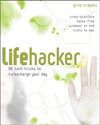
Lifehacker: 88 tech tricks to turbocharge your day,
By Gina Trapani
ISBN 0-470-05065-9
300 pages
US $24.99 CAN $29.99 UK £15.99
http://wiley.com
If most of your productive day-to-day activities revolve around your Mac and related software, you probably keep current on as many strategies, tips, and ideas that help you not only be more productive at the keyboard, but also provide you ways to better organize your daily routines, projects, and – heck – your entire life if need be. And if you’re Mac power user, you no doubt seek out and learn numerous plug-ins, third-party applications, keyboard shortcuts, Applescripts and automations, and even some Unix command that boosts your productivity and technical wizardry.
Well, if you’re not quite as productive and organized as you would like to be, and you haven’t had the time to keep up with all the latest Getting Things Done (GTD) strategies and almost weekly published bata testing and updated applications available in cyberspace, you might consider checking out Gina Trapani’s Lifehacker: 88 tech tricks to turbocharge your day.
If you haven’t heard about or visited Lifehacker.com, you’re probably out of the loop in knowing about the latest computer productivity and personal management strategies produced and used by computer power users. Trapani is a staff member of the Lifehacker.com, an increasingly popular software and productivity Weblog that she helps update several times daily. One mention of your website or software on Lifehacker can mean serious bandwidth override from the thousands of hits your website will get as a result of being linked by Lifehacker.com. I’ve seen some sites literary close down for day after being mentioned on the site.
While I imagine that the site is most popular with college students, I RSS Lifehacker.com and check out its listings about one or two times a week. I always find some practical tips and links for third-party Mac software, D.I.Y. hacks for making your own camera lens hood, or a suggestion for using ChapStick to stop bloody shaving nicks. Most of the blog entries seem to be based on links discovered or passed along to the Lifehacker staff.
Lifehacker the Book
Trapani’s book is pretty much like the website, but it mainly focuses on cross-platform hacks for both Windows XP, Vista and Mac users. No doubt most of the book’s content comes straight from the Lifehacker blog. Chapter headings in the book include: “Free Up Mental RAM,” “Firewall Your Attention,” “Automate Repetitive Tasks,” “Control Your Email,” “Master the Web,” and “Tune Your Computer.”
You certainly don’t or shouldn’t set out to read the book cover to cover, but rather dip in and out of chapters to discover helpful suggestions for better organizing your computer workflow and day-to-day activities.
The first few hacks deal with setting various to-do list strategies that involve say using the free web-based Yahoo! Calendar or managing a todo.txt file at the Unix command line.
There are numerous hacks in the book about using various free and user friendly websites to store notes to yourself or to work collaboratively with others on a project. There are hacks that should be well known to most Mac users, such how to quickly organize and clean up your desktop, using third party applications like VisualDesktops (http://virtuedsktops.info), how to remotely control your home computer, how to use Gmail as an internet hard drive, how to use the power of the free keyboard interface program Quicksilver, which launches applications, websites, Address Book entries, and other types of documents.
Limited Mac Hacks
While the book has many cross-platform hacks, hacks specifically for Mac OS X users comes up short. Trapani tends to focus on Windows and Firefox (dhh…she writes extensions for this popular browser, not Safari) platforms. Her book includes hacks that clearly could be done on a Mac platform, such as one about putting portable applications on a USB flash drive. I have such a drive that includes a copy of Firefox, Thunderbird, several folders of my business related files, and backup copies of my Address Book and iCal calendars that I can access if need be. Or there are some very useful hacks, in my opinion, that could have been written up just for Mac users. For instance, because email can be such a powerful tool for getting things done, Trapani might of included an hack about using MailTags 1.2 (http://www.indev.ca/MailTags.html), an Apple Mail plug-in that helps you build smarter mailboxes, keyword searches, and iCal to-do items. Another Mac hack could have introduced Apple’s Automator application that can help users with repetitive tasks and workflow’s. But, hey, I guess I shouldn’t complain. The same type of hack book could easily be written for OS X users and related applications. There are literally hundreds of ways to save time using your Mac. Dan Frankes’s Mac OS X Power Tools (Sybex 2003) comes close to what I’m talking about.
Overall Rating
Overall, Lifehacker is good book to have have on your shelf or at your bedside. Getting an handle on better organizing our time, our career, and personal responsibilities is a never ending goal for most of us who want to be more productive, as well as make time for life beyond our computers and related projects. This book may not have all the answers to living and working more productively, but it does provide some very useful ideas and pointers to staying on track. After reading about and implementing the use of a simple label maker to re-create and re-organize my most accessed files, I can honestly say that I want to make better use of the type of tips and strategies the Lifehacker suggests. Files that I regularly use are now neatly organized, labeled, and best of all much easier to access. For me, that’s some serious hacking in my office routine.
MyMac.com rating: 4 our 5 (Not enough Mac related hacks. Will someone please write a book like this for Mac users only.)

Leave a Reply
You must be logged in to post a comment.